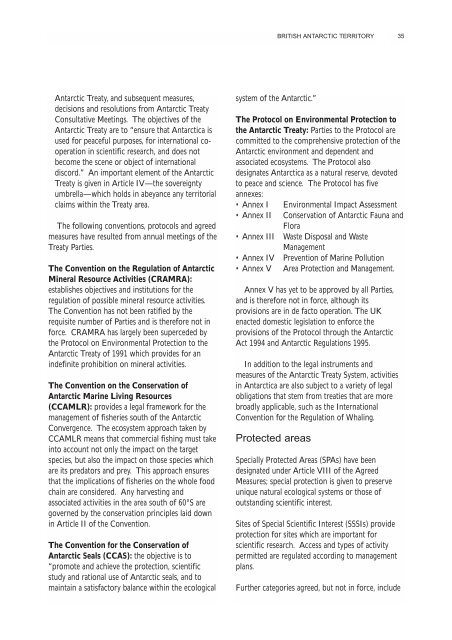Biodiversity: the UK Overseas Territories - WIDECAST
Biodiversity: the UK Overseas Territories - WIDECAST
Biodiversity: the UK Overseas Territories - WIDECAST
Create successful ePaper yourself
Turn your PDF publications into a flip-book with our unique Google optimized e-Paper software.
BRITISH ANTARCTIC TERRITORY<br />
35<br />
Antarctic Treaty, and subsequent measures,<br />
decisions and resolutions from Antarctic Treaty<br />
Consultative Meetings. The objectives of <strong>the</strong><br />
Antarctic Treaty are to “ensure that Antarctica is<br />
used for peaceful purposes, for international cooperation<br />
in scientific research, and does not<br />
become <strong>the</strong> scene or object of international<br />
discord.” An important element of <strong>the</strong> Antarctic<br />
Treaty is given in Article IV—<strong>the</strong> sovereignty<br />
umbrella—which holds in abeyance any territorial<br />
claims within <strong>the</strong> Treaty area.<br />
The following conventions, protocols and agreed<br />
measures have resulted from annual meetings of <strong>the</strong><br />
Treaty Parties.<br />
The Convention on <strong>the</strong> Regulation of Antarctic<br />
Mineral Resource Activities (CRAMRA):<br />
establishes objectives and institutions for <strong>the</strong><br />
regulation of possible mineral resource activities.<br />
The Convention has not been ratified by <strong>the</strong><br />
requisite number of Parties and is <strong>the</strong>refore not in<br />
force. CRAMRA has largely been superceded by<br />
<strong>the</strong> Protocol on Environmental Protection to <strong>the</strong><br />
Antarctic Treaty of 1991 which provides for an<br />
indefinite prohibition on mineral activities.<br />
The Convention on <strong>the</strong> Conservation of<br />
Antarctic Marine Living Resources<br />
(CCAMLR): provides a legal framework for <strong>the</strong><br />
management of fisheries south of <strong>the</strong> Antarctic<br />
Convergence. The ecosystem approach taken by<br />
CCAMLR means that commercial fishing must take<br />
into account not only <strong>the</strong> impact on <strong>the</strong> target<br />
species, but also <strong>the</strong> impact on those species which<br />
are its predators and prey. This approach ensures<br />
that <strong>the</strong> implications of fisheries on <strong>the</strong> whole food<br />
chain are considered. Any harvesting and<br />
associated activities in <strong>the</strong> area south of 60°S are<br />
governed by <strong>the</strong> conservation principles laid down<br />
in Article II of <strong>the</strong> Convention.<br />
The Convention for <strong>the</strong> Conservation of<br />
Antarctic Seals (CCAS): <strong>the</strong> objective is to<br />
“promote and achieve <strong>the</strong> protection, scientific<br />
study and rational use of Antarctic seals, and to<br />
maintain a satisfactory balance within <strong>the</strong> ecological<br />
system of <strong>the</strong> Antarctic.”<br />
The Protocol on Environmental Protection to<br />
<strong>the</strong> Antarctic Treaty: Parties to <strong>the</strong> Protocol are<br />
committed to <strong>the</strong> comprehensive protection of <strong>the</strong><br />
Antarctic environment and dependent and<br />
associated ecosystems. The Protocol also<br />
designates Antarctica as a natural reserve, devoted<br />
to peace and science. The Protocol has five<br />
annexes:<br />
• Annex I Environmental Impact Assessment<br />
• Annex II Conservation of Antarctic Fauna and<br />
Flora<br />
• Annex III Waste Disposal and Waste<br />
Management<br />
• Annex IV Prevention of Marine Pollution<br />
• Annex V Area Protection and Management.<br />
Annex V has yet to be approved by all Parties,<br />
and is <strong>the</strong>refore not in force, although its<br />
provisions are in de facto operation. The <strong>UK</strong><br />
enacted domestic legislation to enforce <strong>the</strong><br />
provisions of <strong>the</strong> Protocol through <strong>the</strong> Antarctic<br />
Act 1994 and Antarctic Regulations 1995.<br />
In addition to <strong>the</strong> legal instruments and<br />
measures of <strong>the</strong> Antarctic Treaty System, activities<br />
in Antarctica are also subject to a variety of legal<br />
obligations that stem from treaties that are more<br />
broadly applicable, such as <strong>the</strong> International<br />
Convention for <strong>the</strong> Regulation of Whaling.<br />
Protected areas<br />
Specially Protected Areas (SPAs) have been<br />
designated under Article VIII of <strong>the</strong> Agreed<br />
Measures; special protection is given to preserve<br />
unique natural ecological systems or those of<br />
outstanding scientific interest.<br />
Sites of Special Scientific Interest (SSSIs) provide<br />
protection for sites which are important for<br />
scientific research. Access and types of activity<br />
permitted are regulated according to management<br />
plans.<br />
Fur<strong>the</strong>r categories agreed, but not in force, include
















